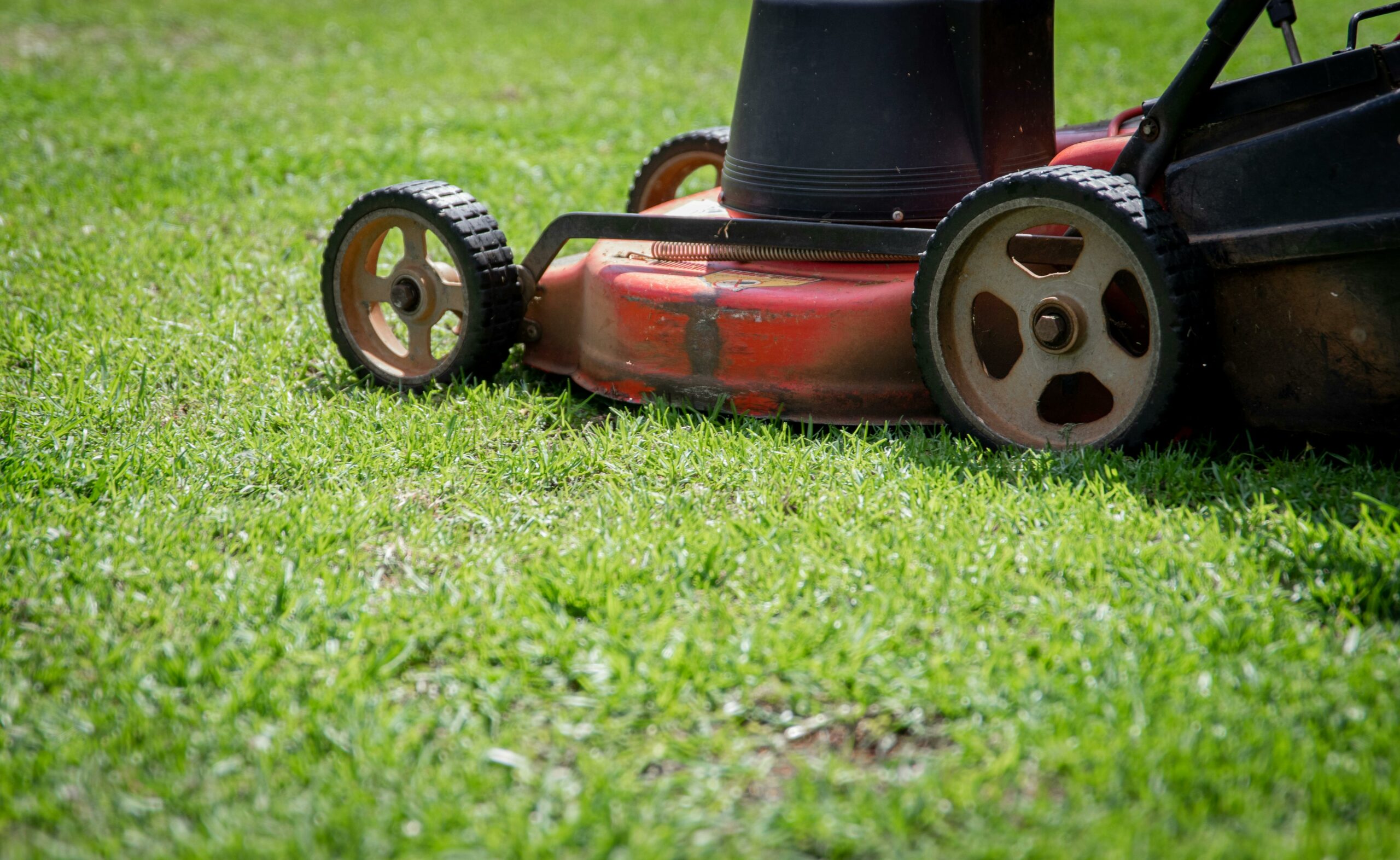Maintaining a visually appealing lawn requires not just dedication but also a keen understanding of proper lawn care techniques. Unfortunately, even the most well-intentioned homeowners can inadvertently make mistakes that undermine their lawn’s health and aesthetic appeal. These errors, often stemming from common misconceptions or a lack of information, can lead to issues like unsightly brown patches and weakened grass.
In this blog post, we aim to shed light on the most prevalent lawn-mowing blunders and provide practical, easy-to-implement solutions. Whether you’re a seasoned gardener or a novice, this guide is designed to help you avoid common mistakes and ensure your lawn remains a lush, thriving oasis that enhances the beauty of your home.
By understanding the nuances of lawn mowing and avoiding these common errors, you can ensure your lawn not only survives but thrives. Join us as we explore how to transform your lawn care practices into a pathway towards achieving the healthy, beautiful lawn you’ve always desired.
Common Lawn Mowing Mistakes and Solutions
Here are some common lawn mowing mistakes and how you can solve them:
Cutting Grass Too Short
One of the most common missteps homeowners make in their lawn care routine is cutting their grass too short. On the surface, mowing the lawn to a very low height might seem like an efficient way to extend the time between mowings, potentially saving effort and time in the short term. However, this practice is counterproductive and can significantly harm your lawn’s health and aesthetic appeal.
When grass is cut too short, it exposes the root system to the harsh effects of the sun and heat, significantly increasing the risk of root burn and dehydration. This exposure not only stresses the grass plants but also weakens their defense against invasive weeds and pests. Furthermore, short grass blades have a reduced surface area for photosynthesis, the critical process by which grass plants convert sunlight into the energy they need to grow and thrive. Limiting this process compromises the grass’s ability to produce the nutrients it needs, leading to a less vigorous lawn that may struggle to recover from environmental stresses.
Moreover, cutting grass too short can lead to soil compaction and a higher soil temperature, which further stresses the lawn and can inhibit root growth. This creates a vicious cycle where the grass becomes increasingly unable to absorb water and nutrients effectively, leading to an unhealthy and unsightly lawn.
Solution: Finding the Optimal Grass Height
To avoid the detrimental effects of cutting your grass too short, it’s essential to understand and implement the concept of the optimal grass height for your specific lawn type. Different species of grass have varying optimal heights at which they perform best, both aesthetically and health-wise. For example, cool-season grasses like fescue and bluegrass thrive when maintained at a height of around 3 to 4 inches, while warm-season grasses such as Bermuda and zoysia may be kept slightly shorter.
Adjusting your mower to the correct height setting is crucial. As a general rule, never remove more than one-third of the grass blade in a single mowing session. This approach encourages deeper root growth, which helps your lawn access moisture and nutrients more efficiently, leading to a denser, more resilient turf.
By respecting the natural growth patterns of your lawn and adhering to the principle of optimal grass height, you can promote a healthier, more robust lawn. This not only enhances the visual appeal of your outdoor space but also contributes to a more vibrant and sustainable garden ecosystem.
Mowing Wet Grass
Mowing wet grass is a common oversight that many homeowners make, often due to time constraints or a simple eagerness to maintain their lawn. While it might seem like a harmless act of diligence, mowing your lawn when it’s wet can lead to a host of problems that compromise the health and appearance of your grass. The moisture makes the grass blades stick together, resulting in uneven cuts that can leave your lawn looking patchy and unkempt. Furthermore, the wet clippings clump together, creating barriers on the lawn that can smother the grass beneath and prevent it from receiving the sunlight it needs.
The risks extend beyond mere aesthetics. Wet conditions are conducive to the spread of fungal diseases, as the dampness provides an ideal environment for spores to thrive and multiply. When you mow wet grass, you inadvertently help spread these pathogens across your lawn, potentially leading to widespread lawn disease.
Additionally, mowing wet grass can be tough on your lawn mower. The wet clippings are more likely to clog the mower’s deck, reducing its efficiency and potentially causing damage over time. This not only makes the task more laborious but can also shorten the lifespan of your mower.
Solution: Timing and Technique for Mowing Wet Grass
The ideal solution is to wait until your lawn has dried before mowing. This simple adjustment in timing can significantly reduce the risk of uneven cuts, clumping, and disease. However, we understand that weather and scheduling don’t always cooperate. If you find yourself in a situation where you must mow wet grass, there are steps you can take to mitigate the negative effects:
- Raise the Mower Blade: Setting your mower to a higher cut can reduce the stress on both the grass and the mower. It helps prevent the clumping of wet clippings and reduces the likelihood of spreading disease.
- Manage the Clippings: If possible, collect and remove the wet clippings from your lawn to prevent them from forming mats that can smother the grass. If your mower has a mulching option, use it cautiously, as mulched wet clippings can still clump together.
- Clean Your Mower: After mowing wet grass, take the time to clean your mower thoroughly. Remove any clumped grass from the blades and deck to prevent rust and maintain efficiency.
By adopting these practices, you can better navigate the challenges of mowing wet grass, ensuring your lawn remains healthy and attractive even when conditions are less than ideal.
Using Dull Blades
Utilizing dull blades on your lawn mower is a mistake that’s easy to overlook but can have significant consequences for the health and appearance of your lawn. When mower blades aren’t sharp, they tend to tear the grass rather than provide a clean cut. This tearing action creates jagged edges on the grass blades, which not only detracts from the overall look of your lawn but also opens the door to a host of potential problems.
Jagged edges on grass blades increase the plant’s susceptibility to stress, pests, and diseases. These rough edges provide an easy entry point for pathogens and can stress the grass, making it harder for it to absorb water and nutrients. This stress can weaken the lawn over time, making it less lush and more likely to succumb to infestations or illness. Moreover, torn grass tips can turn brown, leading to a lawn that looks unhealthy and poorly maintained.
Solution: Ensuring Sharp Blades for a Healthier Lawn
The key to avoiding the detrimental effects of dull mower blades is regular maintenance. Keeping your mower blades sharp ensures that your lawn is cut cleanly, promoting healthier growth and a more aesthetically pleasing appearance. Here are some tips for maintaining sharp mower blades:
- Regular Inspection and Sharpening: Make it a habit to inspect your mower blades regularly for signs of wear or dullness. How often you need to sharpen the blades can vary based on how frequently you mow and the size of your lawn, but a good rule of thumb is to sharpen them at least once per mowing season, or more if you notice tearing the grass blades.
- DIY Sharpening: If you’re comfortable using tools and following safety precautions, you can sharpen mower blades yourself using a bench grinder or a hand file. There are numerous tutorials available that can guide you through the process step by step. Always ensure the mower is unplugged or the spark plug is disconnected before attempting any maintenance.
- Professional Sharpening Services: For those who prefer not to sharpen the blades themselves or lack the necessary equipment, professional sharpening services are a convenient and effective option. Many lawn care shops and hardware stores offer blade sharpening at a reasonable cost. This ensures your blades are sharpened correctly and efficiently, without the need for you to invest in specialized equipment.
By prioritizing the sharpness of your mower blades, you can significantly enhance the health and appearance of your lawn. Sharp blades mean cleaner cuts, which lead to a stronger, more resilient lawn that’s better equipped to withstand pests, diseases, and environmental stresses.
Ignoring Mowing Patterns
Mowing your lawn in the same direction or pattern every time can lead to unintended consequences that affect both the health and aesthetics of your lawn. This repetitive action can cause soil compaction beneath the wheels of the mower, making it difficult for water, air, and nutrients to penetrate the soil and reach the roots of your grass. Additionally, grass tends to lean in the direction it’s mowed, leading to patterned grass growth. Over time, this can result in a lawn that looks striped or uneven, with certain areas potentially growing denser than others, creating an unattractive and inconsistent appearance.
Solution: Diversifying Mowing Patterns for a Healthier Lawn
To combat the issues associated with repetitive mowing patterns, it’s beneficial to vary the direction in which you mow your lawn each time. This practice not only helps prevent soil compaction by distributing the weight and pressure of the mower differently with each mow but also encourages grass to grow more vertically. Here are some strategies to ensure varied mowing patterns:
- Alternate Directions: If you mow north to south one week, switch to mowing east to west the next. This simple change can make a significant difference in the overall health and appearance of your lawn.
- Diagonal Patterns: For a more visually appealing effect, consider mowing diagonally across your lawn. Alternating between diagonal directions with each mow can add a professional-looking finish to your lawn while promoting healthy growth.
- Avoid Ruts: Constantly mowing in the same pattern can lead to the formation of ruts where the mower wheels travel. By changing your mowing pattern, you’ll help avoid creating these depressions in your lawn, which can be difficult to repair.
- Use Different Starting Points: Begin mowing from different sides of your lawn each time. This variation helps reduce wear in any single area and encourages more uniform grass growth.
By implementing these varied mowing strategies, you can promote a more uniform and healthy growth pattern across your lawn. This not only enhances the lawn’s resilience and health by preventing soil compaction and ensuring even exposure to sunlight but also contributes to a more aesthetically pleasing and lush outdoor space. Remember, a little variation in your mowing routine can go a long way in maintaining the vitality and beauty of your lawn.
Skipping Maintenance
Neglecting the maintenance of your lawn mower is a common oversight that can have far-reaching consequences, not just for the machine itself but also for the health and appearance of your lawn. A well-maintained mower operates more efficiently, providing clean cuts that promote healthy grass growth. Conversely, a poorly maintained mower can struggle to perform, leading to uneven cuts, potential lawn damage, and increased wear and tear on the mower.
Solution: A Comprehensive Lawn Mower Maintenance Checklist
To ensure your lawn mower remains in top condition and your lawn looks its best, adhering to a regular maintenance schedule is crucial. Here’s a basic checklist to help you keep your mower running smoothly:
- Clean the Mower After Each Use: Grass clippings, dirt, and debris can accumulate on your mower, leading to rust and corrosion. Clean the underside of the mower deck with a hose (making sure the mower is off and the spark plug is disconnected) to remove clippings and prevent blockages.
- Sharpen the Blades Regularly: Dull blades tear rather than cut the grass, leading to a less healthy lawn. Sharpen the blades at least once a season or more frequently if you notice the grass isn’t being cut cleanly.
- Check and Change the Oil: Just like any engine, your lawn mower’s engine needs clean oil to operate efficiently. Check the oil level before each use and change it according to the manufacturer’s recommendations, usually once per mowing season.
- Inspect and Replace the Air Filter: A dirty air filter can reduce the efficiency of your lawn mower’s engine and cause it to use more fuel. Check the air filter regularly and replace it as needed to ensure your mower runs smoothly.
- Check the Fuel: Old or contaminated fuel is a common cause of mower problems. Make sure to use fresh fuel and consider adding a fuel stabilizer if you won’t be using the mower for an extended period.
- Inspect Spark Plugs: Spark plugs are essential for starting your mower, and a faulty spark plug can prevent it from starting at all. Check spark plugs annually and replace them if they’re worn or damaged.
- Tighten Loose Bolts and Screws: Vibrations from mowing can loosen bolts and screws over time. Periodically check and tighten them to ensure your mower is safe and effective.
- Check the Wheels and Adjustments: Ensure the wheels are secure and the height adjustment mechanism is working correctly. This ensures you can easily adjust the cutting height as needed for different areas of your lawn.
By following this maintenance checklist, you can extend the life of your lawn mower and ensure it performs at its best. Regular upkeep not only saves you time and money on repairs but also helps you achieve a healthier, more attractive lawn.
The Value of Professional Lawn Mowing Services
In the quest for a pristine and thriving lawn, the expertise and precision that professional lawn mowing services offer can be invaluable. For many homeowners, the time, effort, and knowledge required to maintain a lawn to the highest standards can be overwhelming. This is where the benefits of hiring professionals like Lawn Edging come into play. Our team not only brings expertise and efficiency to the task but also a deep understanding of the nuanced needs of different types of lawns. Opting for professional services ensures that your lawn receives the care it needs to flourish, reflecting well on your home’s overall appearance and value.
Why Lawn Edging Stands Out
At Lawn Edging, we’re not just about mowing lawns; we’re about creating and maintaining outdoor spaces that homeowners can be proud of. Our commitment to lawn health and customer satisfaction sets us apart in several ways:
- Expertise and Equipment: Our seasoned professionals are equipped with the latest in lawn care technology, ensuring that every blade of grass is perfectly cut and that your lawn remains healthy and resilient against pests and diseases.
- Customized Lawn Care Plans: Recognizing that every lawn is unique, we offer bespoke lawn care solutions tailored to the specific needs of your outdoor space. Whether it’s selecting the right mowing height or identifying the optimal fertilization plan, our approach is always personalized.
- Holistic Lawn Health Focus: Our philosophy extends beyond mere aesthetics. We aim to nurture your lawn’s health from the roots up, ensuring it is lush, green, and vibrant. This holistic approach means we’re constantly looking for ways to improve soil health, enhance grass density, and ensure your lawn is sustainable and environmentally friendly.
- Avoidance of Common Mistakes: With Lawn Edging, you can rest assured that the common pitfalls of lawn mowing are avoided. Our professionals are trained to sidestep issues like cutting grass too short or mowing when wet, employing strategies that promote the long-term well-being of your lawn.
Ready to elevate your lawn to the next level? Contact Lawn Edging today for a consultation or to schedule your professional lawn mowing service. Let us take the hassle out of lawn care, allowing you to enjoy a stunning, healthy lawn year-round. With Lawn Edging, your dream lawn is just a call away.
Our services are available in various suburbs and localities in Sydney and Melbourne.
Conclusion
Evading common lawn mowing mistakes is crucial for the upkeep of a healthy and aesthetically pleasing lawn. By adhering to our advice and enlisting Lawn Edging’s professional lawn mowing services, you can attain the lawn you’ve always desired. Don’t hesitate to contact us for all your lawn care necessities.


